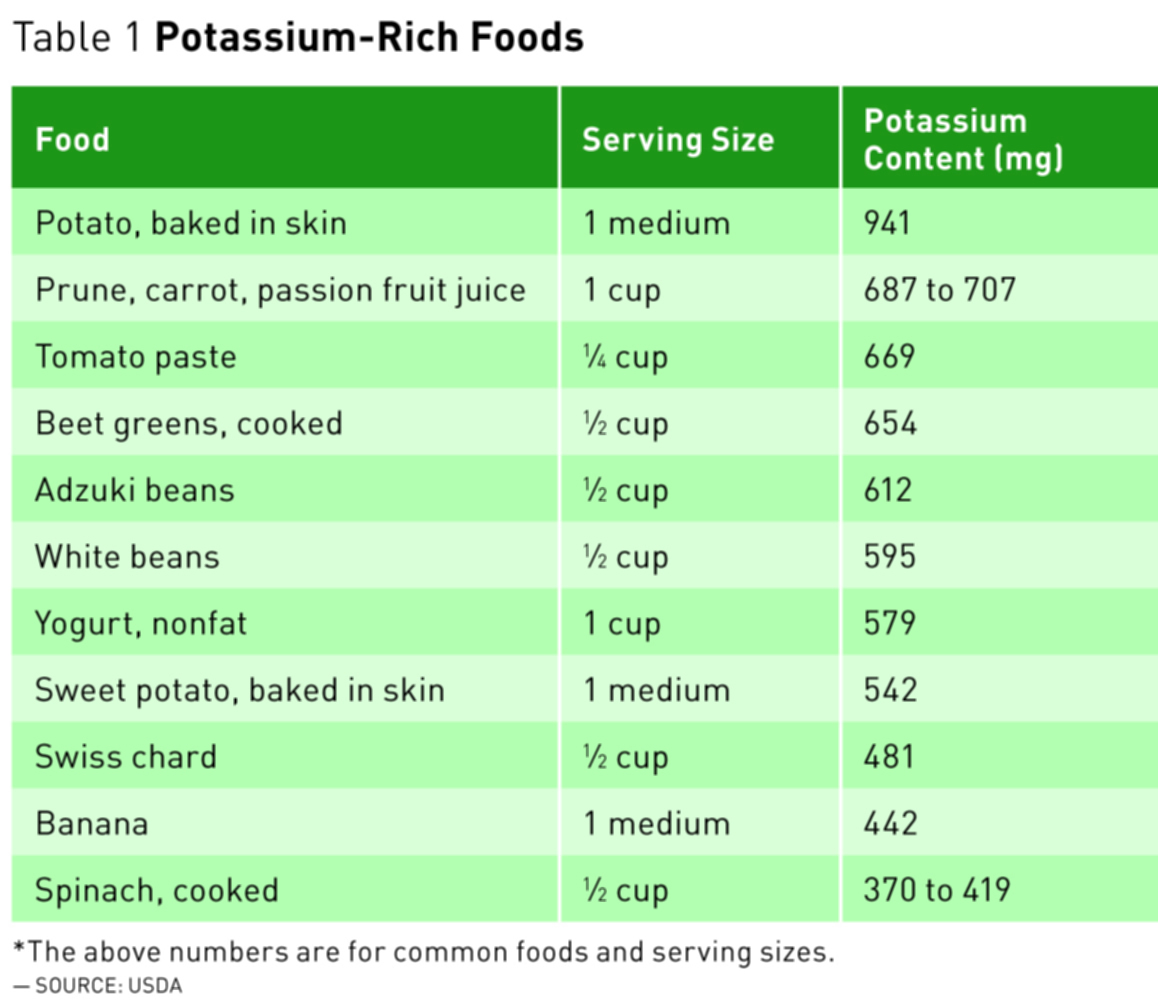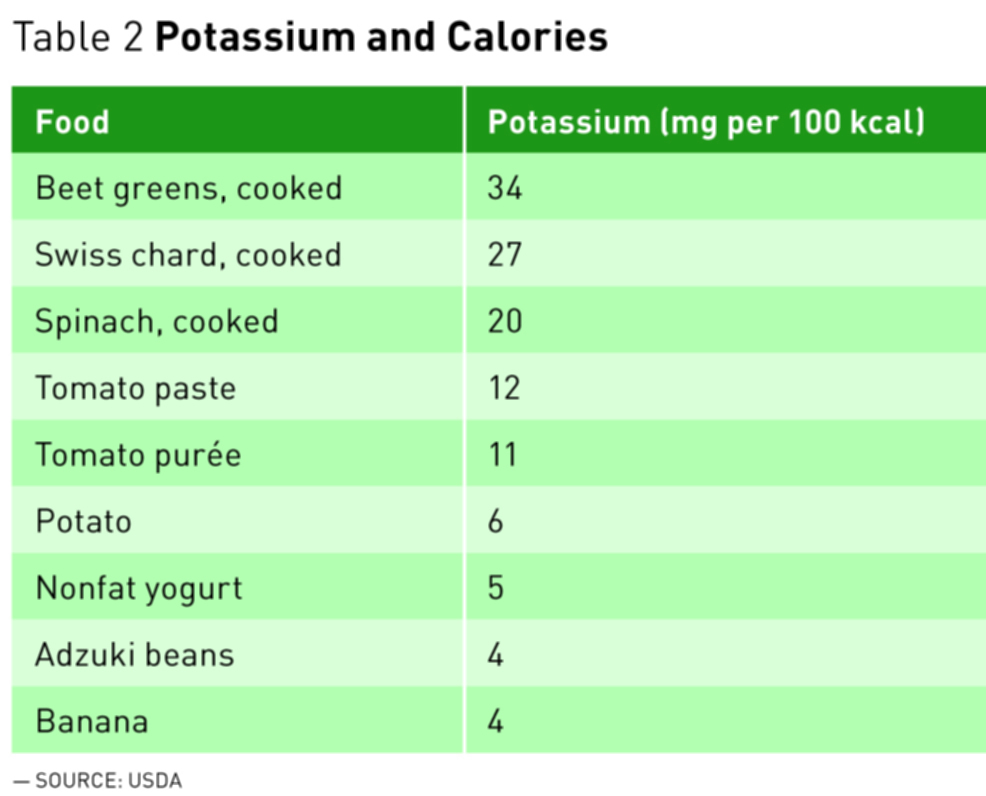Today’s Dietitian
Vol. 18 No. 2 P. 12
Eating more fruits and veggies can help prevent CVD and its risk factors.
Potassium hasn’t been harshly criticized like sodium nor has received the praise calcium enjoys, but this readily available though underconsumed nutrient plays a crucial role in both short- and long-term health. Often associated with bananas, potassium resides in many other fruits and vegetables, and clients who meet daily requirements can reduce their risk of cardiovascular disease (CVD) and its risk factors such as hypertension.1
However, no discussion of potassium is complete without mentioning its cousin in the electrolyte family: sodium. High sodium intake raises the risk of hypertension; it also increases arterial pressure and may exacerbate hypertension in those who have it.2 Yet, a reduction in sodium intake can reduce blood pressure in hypertensive and normotensive adults.2
While potassium is underconsumed, sodium is overconsumed due to Americans’ proclivity to eat processed foods more often than fresh fruits and vegetables. What clients should know is that including potassium-rich foods in the diet can be a simple strategy to lower CVD risk.3 Potassium is one of the major cations (positively charged ions) of intracellular fluid and along with the other electrolytes, such as sodium, calcium, magnesium, chloride, and phosphorus, it maintains the body’s fluid balance. These electrolytes conduct electricity in the body and play a crucial role in muscle contraction, cellular-membrane potential, acid-base homeostasis, and several cardiovascular functions. Most relevant to this discussion, potassium moderates blood pressure. Where sodium is associated with an increased risk of hypertension, potassium may reduce risk as a vasodilator.4

Potassium Recommendations
The Institute of Medicine set the Adequate Intake (AI) for potassium in adults of all ages at 4,700 mg per day; some estimates of actual daily intake in the United States range from 2,800 to 3,300 mg for men and 2,200 to 2,400 mg for women, well below recommendations.5 The FDA designated potassium a nutrient of “public health significance” due to underconsumption and is proposing to add it to the next update of the Nutrition Facts Panel so consumers can prioritize it and recognize potassium-rich foods.6 Currently, the DV for potassium for adults, based on a 2,000 kcal diet, is 3,500 mg. Internationally, the World Health Organization (WHO) has made a “strong recommendation” to increase potassium intake via food to reduce CVD risk. According to the WHO, “Increased potassium intake reduced systolic and diastolic blood pressure in adults. Across a wide range of baseline intakes, increasing potassium intake was beneficial in terms of blood pressure.” Those who are salt-sensitive also benefit from adequate potassium intake. The WHO recommends all adults consume 3,510 mg of potassium daily.7
More recently, the 2015 Scientific Report of the Dietary Guidelines Advisory Committee called potassium a “nutrient of public health concern” because national intake is far below recommendations. For example, only 3% of older adults meet the AI for potassium. The report states, “there is a particular concern for middle-aged and older adults who are at increased risk for cardiovascular diseases. Fruits, vegetables, and legumes are all important sources of potassium.”8 The benefits of reducing blood pressure and preventing hypertension are multiplied because hypertension is deemed the silent killer—and its presence increases risk of all CVDs.
The benefits of potassium in CVD prevention, however, may go beyond sodium-potassium blood pressure moderation. A small study published in 2014 in Nutrition Journal showed an inverse relationship between potassium intake and arterial stiffness in young, healthy adults.9 The researchers didn’t test endothelial function, but argued that it’s established that potassium increases nitric oxide production, which protects the endothelium and increases blood flow. Phytochemicals found in fruits and vegetables also may increase nitric oxide production and offer additional protection of the endothelium.
Reed Mangels, PhD, RD, LDN, nutrition advisor for the Vegetarian Resource Group, identifies another potential benefit of potassium-rich produce consumption: bone health. She says the potassium in fruits and vegetables is associated with citrate and other bicarbonate precursors that have an alkalizing effect. This increased alkaline state results in lower calcium losses in the urine. While meats, dairy products, and cereals also are potassium sources, they have fewer bicarbonate precursors so they aren’t as effective at inducing an alkaline state.10

Tips for Counseling Patients
Potassium is found in varying amounts in nearly all foods, though some are better sources than others. Dietitians who want to improve potassium intake among clients and patients should focus on promoting beans (eg, adzuki, white), white and sweet potatoes, and vegetables, specifically leafy greens (eg, beet greens, Swiss chard). Other notable foods containing potassium are bok choy, beets, Brussels sprouts, and broccoli.
Simply providing a list of potassium-rich foods for clients to try usually isn’t enough to promote lasting change. To encourage sustainable dietary changes, dietitians should use the following strategies when counseling clients:
• Emphasize small changes. Many clients take an all-or-nothing approach that can set them up for failure, but adding just a few servings of fruits and vegetables each day can have a significant impact on their health.
• Meet clients where they are. Some individuals are ready to try different recipes and learn about new, healthful foods, while others still need to be convinced that diet matters. So discuss what potassium is and its importance in lowering risk of hypertension and stroke. This information is a strong talking point.
• Focus on potassium. Clients may find it easier to maximize potassium intake by adding new foods rather than reducing sodium. So encourage them to eat plenty of plant foods to displace some of the refined, high-sodium cuisine in their diets. Simple swaps can make a huge difference.
• Eat more of the familiar. Recommend patients increase the number of servings of the fruits and vegetables they already eat. Many will find this suggestion an easy, measurable goal.
• Reach for canned or frozen leafy vegetables. If clients don’t have time to prepare fresh leafy vegetables, suggest they try canned, frozen, or leftover greens, which still maintain their potassium content. However, if they choose canned vegetables, they should select low-sodium varieties. Another alternative: Recommend they rinse canned vegetables in a colander or strainer to remove excess sodium before food preparation and cooking.
• Mix it up. Suggest patients combine a variety of potassium-rich vegetables with soups, stews, or tomato sauce (also an excellent potassium source). The vegetables will maintain their potassium content and contribute to a healthful, hearty meal.
• Eat some taters. Potatoes are an excellent source of potassium. They can be baked or boiled and added to a variety of meals. Suggest clients explore the many types and colors available to add variety to their diet.
• Try dried fruit. Recommend patients add dried fruits like peaches, prunes, and apricots to oatmeal and cold breakfast cereals, or eat them as snacks.
“Think supersize when it comes to serving sizes, especially for vegetables,” Mangels says. “I use lightly steamed vegetables stuffed in a whole wheat pita pocket with some beans or tofu and a spread (eg, mustard-tahini sauce or hummus) as one of my favorite lunches.” Mangels estimates that she eats two cups of steamed vegetables (four servings) this way and says that the whole wheat pita and beans provide additional potassium.
Dietitians who recommend these strategies will become a crucial link to helping clients and patients meet their daily potassium needs and live healthier lives.
— Matthew Ruscigno, MPH, RD, is the past chair of the Vegetarian Nutrition Dietetic Practice Group of the Academy of Nutrition and Dietetics. He’s the coauthor of No Meat Athlete and Appetite for Reduction and has a private practice in Los Angeles.
References
1. Adrogué HJ, Madias NE. The impact of sodium and potassium on hypertension risk. Semin Nephrol. 2014;34(3):257-272.
2. Frohlich ED, Varagic J. The role of sodium in hypertension is more complex than simply elevating arterial pressure. Nat Clin Pract Cardiovasc Med. 2004;1(1):24-30.
3. Drewnowski A, Rehm CD, Maillot M, Monsivais P. The relation of potassium and sodium intakes to diet cost among U.S. adults. J Hum Hypertens. 2015;29(1):14-21.
4. Haddy FJ, Vanhoutte PM, Feletou M. Role of potassium in regulating blood flow and blood pressure. Am J Physiol Regul Integr Comp Physiol. 2006;290(3):R546-R552.
5. National Academy of Sciences, Institute of Medicine. Dietary Reference Intakes: The Essential Guide to Nutrient Requirements. Washington, DC: National Academy Press; 2006:370-379.
6. US Food and Drug Administration. Proposed Changes to the Nutrition Facts Label. http://www.fda.gov/Food/GuidanceRegulation/GuidanceDocumentsRegulatoryInformation/
LabelingNutrition/ucm385663.htm. Updated July 2015.
7. World Health Organization. Guideline: potassium intake for adults and children. http://www.who.int/nutrition/publications/guidelines/potassium_intake_printversion.pdf. Published 2012. Accessed December 10, 2015.
8. US Department of Health and Human Services and the US Department of Agriculture. Scientific Report of the 2015 Dietary Guidelines Advisory Committee. http://health.gov/dietaryguidelines/2015-scientific-report/. Published February 2015. Accessed December 10, 2015.
9. Lennon-Edwards S, Allman BR, Schellhardt TA, Ferreira CR, Farquhar WB, Edwards DG. Lower potassium intake is associated with increased wave reflection in young healthy adults. Nutr J. 2014;13:39.
10. Lanham-New SA. The balance of bone health: tipping the scales in favor of potassium-rich, bicarbonate-rich foods. J Nutr. 2008;138(1):172S-177S.


